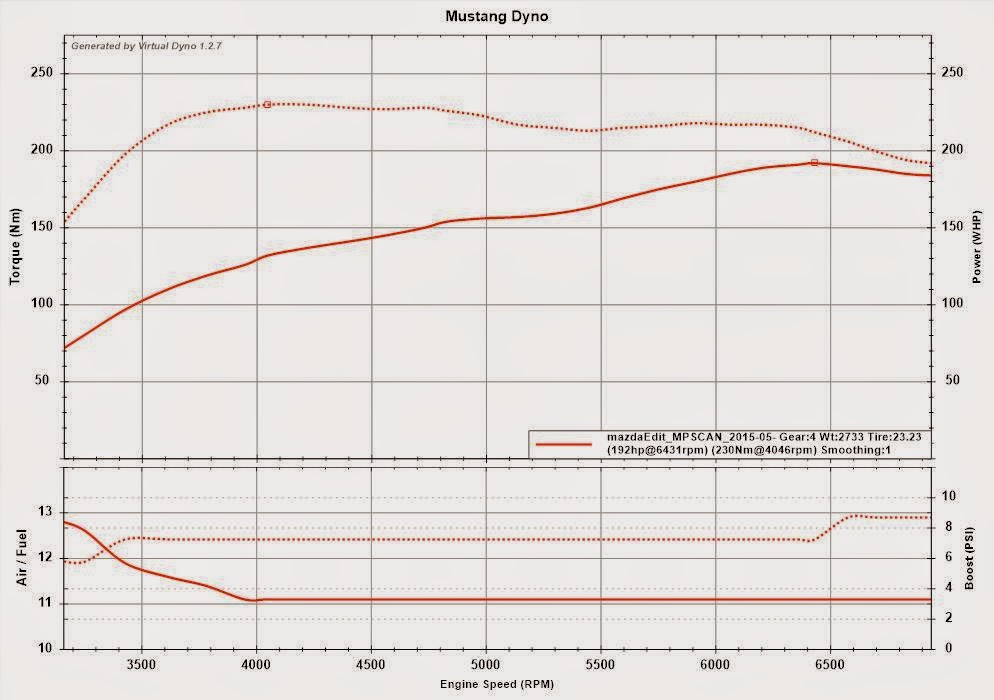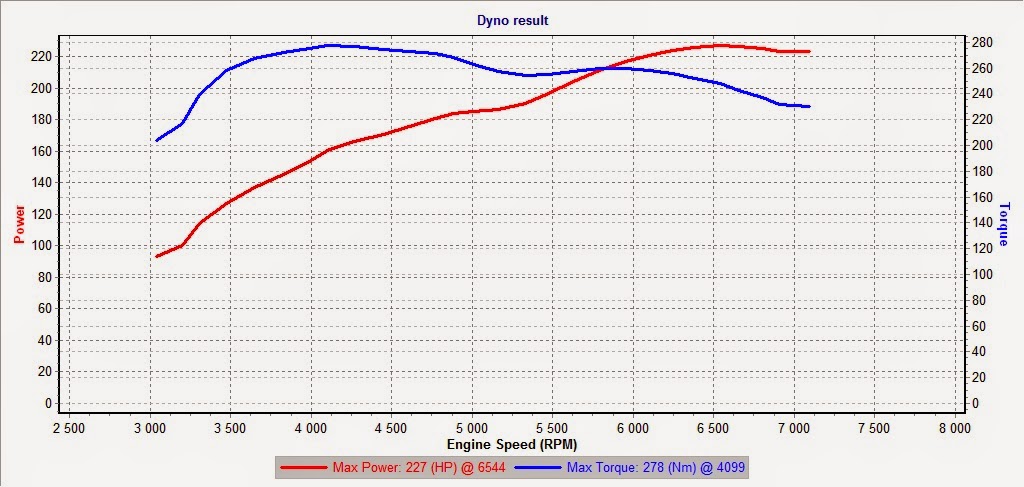Calculating hp and tq using Virtual Dyno and MazdaEdit on a MX-5 NC
I had a go at measuring horse power and torque today using Virtual Dyno and the Dyno function in the MazdaEdit LogViewer.
Both are based on the same method; measuring the time it takes to accelerate between RPM points and then calculate hp and tq based on weight and gearing ( gear, final drive and driven wheel diameter)
The source is a log file that included at least TPS (to detect 100% throttle), RPM and TIME. VD supports a huge amount of EMS and OBDII loggers including MazdaEdit, ECUTek etc.
IND over at m.net has a nice writeup with results for both VD and actual Mustang dyno numbers here :
http://forum.miata.net/vb/showthread.php?t=556444
It is essential to get all the parameters 100% to get credible readings:
- A long stretch of straight and flat road. Measure both ways and average the results.
- Actual measured weight of the car + driver
- Actual distance from the surface to the center of the driven wheel x 2. Calculated size using tire width,profile,rim will not be 100% correct.
- Gear ratios for both the diff and trans.
- In which gear you did the pull.
For my car this resulted in :
Weight car + driver 1160kg + 80kg = 1240 kg (full tank, some gear in the trunk)
Gear ratios for 6 speed box (EU):
<table border="0" cellpadding="5" cellspacing="0" style="background-color: white; border-collapse: collapse; border-spacing: 0px; box-sizing: border-box; color: #636363; font-family: 'Helvetica Neue', Verdana, Arial, sans-serif; font-size: 14px; line-height: 21px; margin: 0px; padding: 0px;"><tbody style="box-sizing: border-box; margin: 0px; padding: 0px;"><tr style="box-sizing: border-box; margin: 0px; padding: 0px;"><td align="center" style="box-sizing: border-box; margin: 0px; padding: 0px;" valign="middle"></td><td align="center" style="box-sizing: border-box; margin: 0px; padding: 0px;" valign="top"><table border="1" cellpadding="0" cellspacing="0" style="border-collapse: collapse; border-spacing: 0px; box-sizing: border-box; color: #636363; font-size: 14px; line-height: 1.5; margin: 0px; padding: 0px; width: 250px;"><tbody style="box-sizing: border-box; margin: 0px; padding: 0px;"><tr style="box-sizing: border-box; margin: 0px; padding: 0px;"><th scope="col" style="box-sizing: border-box; font-weight: normal; margin: 0px; padding: 0px;"></th><th align="center" scope="col" style="box-sizing: border-box; font-weight: normal; margin: 0px; padding: 0px;">ratio</th><th align="center" scope="col" style="box-sizing: border-box; font-weight: normal; margin: 0px; padding: 0px;"><div id="RPMdisplay" style="box-sizing: border-box; margin: 0px; padding: 0px;">mph @7200 rpm</div></th></tr><tr style="box-sizing: border-box; margin: 0px; padding: 0px;"><td style="box-sizing: border-box; margin: 0px; padding: 0px;">1st</td><td align="center" style="box-sizing: border-box; margin: 0px; padding: 0px;"><div id="ratio1" style="box-sizing: border-box; margin: 0px; padding: 0px;">3.709</div></td><td align="center" style="box-sizing: border-box; margin: 0px; padding: 0px;"><div id="speed1" style="box-sizing: border-box; margin: 0px; padding: 0px;">32.5</div></td></tr><tr style="box-sizing: border-box; margin: 0px; padding: 0px;"><td style="box-sizing: border-box; margin: 0px; padding: 0px;">2nd</td><td align="center" style="box-sizing: border-box; margin: 0px; padding: 0px;"><div id="ratio2" style="box-sizing: border-box; margin: 0px; padding: 0px;">2.190</div></td><td align="center" style="box-sizing: border-box; margin: 0px; padding: 0px;"><div id="speed2" style="box-sizing: border-box; margin: 0px; padding: 0px;">55.0</div></td></tr><tr style="box-sizing: border-box; margin: 0px; padding: 0px;"><td style="box-sizing: border-box; margin: 0px; padding: 0px;">3rd</td><td align="center" style="box-sizing: border-box; margin: 0px; padding: 0px;"><div id="ratio3" style="box-sizing: border-box; margin: 0px; padding: 0px;">1.536</div></td><td align="center" style="box-sizing: border-box; margin: 0px; padding: 0px;"><div id="speed3" style="box-sizing: border-box; margin: 0px; padding: 0px;">78.5</div></td></tr><tr style="box-sizing: border-box; margin: 0px; padding: 0px;"><td style="box-sizing: border-box; margin: 0px; padding: 0px;">4th</td><td align="center" style="box-sizing: border-box; margin: 0px; padding: 0px;"><div id="ratio4" style="box-sizing: border-box; margin: 0px; padding: 0px;">1.177</div></td><td align="center" style="box-sizing: border-box; margin: 0px; padding: 0px;"><div id="speed4" style="box-sizing: border-box; margin: 0px; padding: 0px;">102.4</div></td></tr><tr style="box-sizing: border-box; margin: 0px; padding: 0px;"><td style="box-sizing: border-box; margin: 0px; padding: 0px;">5th</td><td align="center" style="box-sizing: border-box; margin: 0px; padding: 0px;"><div id="ratio5" style="box-sizing: border-box; margin: 0px; padding: 0px;">1.000</div></td><td align="center" style="box-sizing: border-box; margin: 0px; padding: 0px;"><div id="speed5" style="box-sizing: border-box; margin: 0px; padding: 0px;">120.5</div></td></tr><tr style="box-sizing: border-box; margin: 0px; padding: 0px;"><td style="box-sizing: border-box; margin: 0px; padding: 0px;">6th</td><td align="center" style="box-sizing: border-box; margin: 0px; padding: 0px;"><div id="ratio6" style="box-sizing: border-box; margin: 0px; padding: 0px;">.832</div></td><td align="center" style="box-sizing: border-box; margin: 0px; padding: 0px;"><div id="speed6" style="box-sizing: border-box; margin: 0px; padding: 0px;">144.9</div></td></tr></tbody></table></td></tr></tbody></table>Gearing info for all MX-5/Miata can be found here https://www.flyinmiata.com/tech/gearing.php
<div>Final drive: 4.10</div><div>Wheel diameter (205/50-16) : Calculated : 24.07” Actual: 23.23” (29.5cm x 2 ) </div><div>
</div><div>I only got one single pull in 4th before it started raining so my results are probably off. </div><div>5th gear with 1:1 would be optimal as there is less drive train loss when direct drive = more power to the ground. But 7K rpm in 5th is 200+ km/h. Not safe.</div><div>
</div><div>Here is my less then satisfactory VD plot using the Mustang dyno correction factor of 0.95</div><div>
</div><div class="separator" style="clear: both; text-align: center;"> </div>Less than 200whp … I had hoped closer to 230. Similar setups have seen 220ish with the stock 2.5 cams so I guess I have a lot of tuning ahead of me. No VVT doesn’t help either.
</div>Less than 200whp … I had hoped closer to 230. Similar setups have seen 220ish with the stock 2.5 cams so I guess I have a lot of tuning ahead of me. No VVT doesn’t help either.
Just for fun I tried to use the same numbers and log on the MazdaEdit Logviewer Dyno function and got this:
<div class="separator" style="clear: both; text-align: center;"> </div><div>
</div><div>
</div><div>Thats 227whp. One reason for some of the difference is that MazdaEdit uses 0.98 for the Mustang dyno correction factor. I double checked the numbers and they are exactly the same (weight, gearing,diameter). Since VD has a much larger user base I think the VD numbers are more trustworthy for the same correction factor.
About correction factor…. The Dynojet correction factor is 1.09 in VD which results in 220whp at the wheels for the exact same log and data… 28 whp difference. This makes it hard to believe dyno claims from vendors that only publishes hp and tq numbers.
I think VD and similar is a really valuable as a tuning tool to verify changes in the tune. The only real downside is that it can be hard to find a good stretch of road suitable for doing pulls.
I can’t wait to play with this more and get a final base line that I’ll use for further tuning.
</div>

Comments